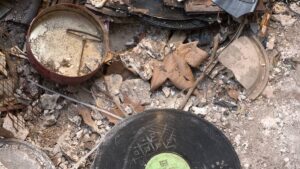Dr Boreham’s Crucible: Is the end of painful biopsies in BCal Diagnostics’ blood?

Pic: REB Images / Tetra images via Getty Images
As with other types of medical imaging, breast cancer diagnosis has taken great leaps forward with the use of techniques such as 3D screening and ultrasound.
Yet mammograms – the standard of care – have a miserable reliability rate of between 60 per cent and 85 per cent.
In this context, the recently-listed BCal Diagnostics (ASX:BDX) hopes to reduce the incidence of both false positives and false negatives with a blood-based, molecular diagnostics-based test.
The desired endgame is reducing the number of painful biopsies, but also ensuring that the most vulnerable women have access to regular cost-effective screening.
The raw reality is that mammograms miss 20 per cent of all tumors, while 80 per cent of follow-up biopsies are not needed.
“The goal of the company is to get to market as quickly as we can within the data and compliance requirements for clinical validation and regulatory approvals,” says executive chair Jayne Shaw.
About BCal
The company was founded by the Lancashire-born Shaw, who is not only a career healthcare professional but an entrepreneurial dynamo.
“All the girls in my family were nurses and all the boys were engineers,” she said.
After migrating to Australia in 1990, Shaw became the director of nursing and CEO of two NSW hospitals “at a reasonably young age”.
Along the way, she noticed the poor clinical outcomes for breast cancer patients – especially depending on where they lived.
In 2000, she co-founded the eyecare clinic consolidation play Vision Group, which listed on the ASX and eventually was acquired by Chinese interests.
After that foray she invested in the Sydney Breast Clinic, where she teamed up with former New South Wales Liberal Party Health Minister Ron Phillips.
“We both wanted to make a difference with early diagnosis of breast cancer, it was a meeting of minds,” she says.
Eventually Sydney Breast Clinic was sold to Healthscope, after which she turned her attention to a blood-based test being developed by a company working at the clinic.
“We bought the [intellectual property], recruited some scientists and funded some research with the backing of high-net-worth individuals, who knew it was high risk but could make a meaningful impact.”
Some of the intellectual property derives from Louisville University, which was replicating some of the scientific work. BCal has an exclusive licence agreement with the Kentucky’s University of Louisville for breast and lung cancer.
BCal listed on the ASX on July 19, 2021, having raised $10 million at 25 cents apiece.
The company funded research in the US for six years, but in 2017 re-domiciled the program to the University of Sydney’s Charles Perkins Centre (which has the requisite mass spectrometry infrastructure).
A notable member of BCal’s five-strong scientific team is Dr Amani Batarseh, a molecular biologist and leading expert in lipidomic and mass spectrometry.
“We were blessed to be able to recruit her,” Shaw says.
A towering inclusion on the board is experienced investment banker and company director Mark Burrows, who has been known more for playing at the big end of town.
“We have to take a few noughts off the numbers because he is used to much bigger figures,” Ms Shaw quips.
About the BCal test
The BCal test – which, like the horse in the desert, does not have a name – is based on an algorithmic software component.
The blood sample is drawn from the patient and then the extracellular vesicles (EVs) are enriched from the blood plasma that contain lipids (types of fats).
The blood is then matched against a panel of 18 biomarkers “characteristic of the presence of blood cancers”.
Initial studies at Charles Perkins suggests the tests are 91 per cent accurate in identifying patients with the disease and 87 percent right in calling out those without a tumor.
Regulatory approach
The company’s regulatory and commercial approach is to tackle the local market first, through an application to the Therapeutic Goods Administration, in parallel with a laboratory-developed-test pathway to market.
The BCal test’s first market entry will be as an adjunct with mammography – certainly not a replacement for it.
Along the way, BCal is augmenting its database of 1,000 or so samples with blood specimens from the Sydney Breast Clinic, Lifehouse, the Specialist Cancer Breast Surgery Centre adjacent to Melbourne’s Epworth Hospital and New South Wales Breast Screening (controversially closed during the Sydney pandemic crisis).
“Our gold standard and purpose are to have a routine screening blood test for all women everywhere, but you need high volumes of clinical samples and clinical data,” Ms Shaw says.
“The aim is to get an Australian lab partner to work to develop that.”
BCal is also in discussion with US parties, which is not surprising given the US accounts for 60 per cent of the breast cancer diagnostics market.
Of course, the proudly parochial US regulators prefer applicants with home-sourced samples that are as American as apple pie and annoying family sitcoms.
“We are realistic that there is only so much we can do in Australia and we need to start collecting clinical data in the US as well,” Shaw says.
BCal also has a licencing arrangement with the University of Louisville covering a similar blood assay for lung cancer.
“But I would rather get one thing right and then diversify, rather than being all things to all people.”
The problem with mammograms
Poor accuracy aside, the wider problem with mammograms is that 50 per cent of eligible women opt not to have them, either because of the pain involved or because they are unwilling to bare their breasts for cultural reasons.
Screening is low among women of certain Asian, Middle Eastern and Mediterranean backgrounds. Breast cancer is also much more fatal in developing countries where healthcare is of lower quality due to later diagnosis.
In Britain, last year’s prolonged Covid-19 lockdowns resulted in about one million fewer mammograms being carried out – and an uptick in late-stage cancers because of tardy diagnosis.
In 12 to 18 months’ time, we will see if the same trend is evident here.
Accuracy aside, the problem with mammograms is that in Australia they are not funded for women aged under 40 (the cut-off used to be 50). So, unless they are deemed high risk because of a BRCA gene mutation, younger women must rely on inaccurate self-examination.
Breast cancers in the under 40s tends to be more aggressive.
Finances and performance
BCal’s initial public offer raised $2 million more than the targeted $8 million, but as is often the case the shares failed to ignite after some of the original investors availed of the opportunity to sell.
It didn’t help that Cicada, Sydney University’s commercialization incubator, had to sell its entire stake in BCal.
Yep – times are tough in academia.
To date, BCal shares have traded between 25 cents (July 21) and 14 cents (August 23).
Shaw estimates the Americans (Louisville University) spent about $US20 million ($27 million) on the intellectual property, with the Australian end investing a further $8 million to $10 million.
She adds that the company has also benefited from pro-bono input, such as directors and lawyers working for nothing during six years of “hand to mouth” existence.
“We are very prudent with our cash; we treat every dollar as if it is our own,” she says.
Sizing up the rivals
Blood-based diagnosis is a very active area globally, notwithstanding the reputational damage inflicted by US company Theranos and its founder Elizabeth Holmes.
(Holmes is currently on trial on fraud charges relating to the $US9 billion collapse of Theranos, which claimed to be developing a pin-prick test for multiple indications).
In the US, Provista Diagnostics has blood-based cancer tests on market.
BCal is being closely compared with the ASX-listed blood-based diagnostics peer Bard1, which merged with Sienna Diagnostics.
Bard1 is targeting breast and ovarian cancers, but its tests are based on antibodies rather than lipids.
Shaw admits that BCal is not alone, but adds that it’s not a winner-takes-all race.
“As with prostate cancer or colorectal cancer there will be many tests on the market and that’s why it’s important to have good clinical data and the support of the medical community, and we think BCal is well positioned in this regard.”
BCal is also ‘competing’ with deep-pocketed companies such as Grail and Guardant Health of the US, which are working on pan-cancer tests.
There are other genomic tests, but so far, no blood test for breast cancer.
She suspects the molecular testing efforts eventually will consolidate in favor of the most accurate and cost-effective assays.
“It’s going to come down to the specificity and sensitivity of the test, clinical utility and price,” Shaw says.
There’s also the Kiwi-based, ASX-listed Volpara Health Technologies, which has tools to enable more accurate imaging of dense-breasted women (tumors on dense breasts do not show up as well as those on fatty breasts).
“We all have the same purpose that earlier diagnosis will lead to improved survivability rates for women with breast cancer.”
Dr Boreham’s diagnosis:
In a bout of rare honesty for a CEO, Shaw describes the share performance to date as “very turbulent and disappointing”.
C’mon Jayne, cheer up: we’ve seen a lot worse than a recently-listed stock trading at a 28 per cent discount.
She adds: “I can’t do anything about the share price, we can only deliver milestones and we are doing that.”
Lest we forget, breast cancer is the world’s most common cancer for women, with two million new diagnoses a year and 627,000 deaths.
In Australia 20,000 cases are detected annually, with 3,000 deaths.
The global testing market is worth about $US5 billion and is forecast to rise to $US8.7 billion by 2027, but Ms Shaw has no delusions about the odds of success.
“It’s risky, there’s no question,” she says. “I’m a realist but we are very focused on getting a test to market.”
Disclosure: Dr Boreham is not a qualified medical practitioner and does not possess a doctorate of any sort. But he does possess man boobs and does his breast to makes sense of the technical stuff.
This column first appeared in Biotech Daily
UNLOCK INSIGHTS
Discover the untold stories of emerging ASX stocks.
Daily news and expert analysis, it's free to subscribe.
By proceeding, you confirm you understand that we handle personal information in accordance with our Privacy Policy.








